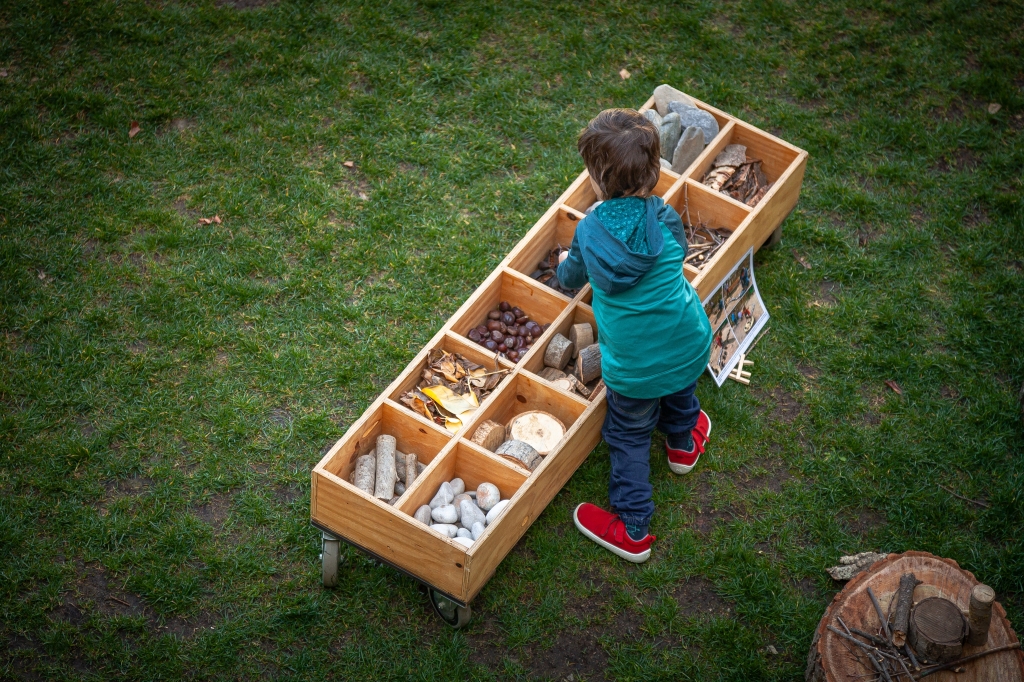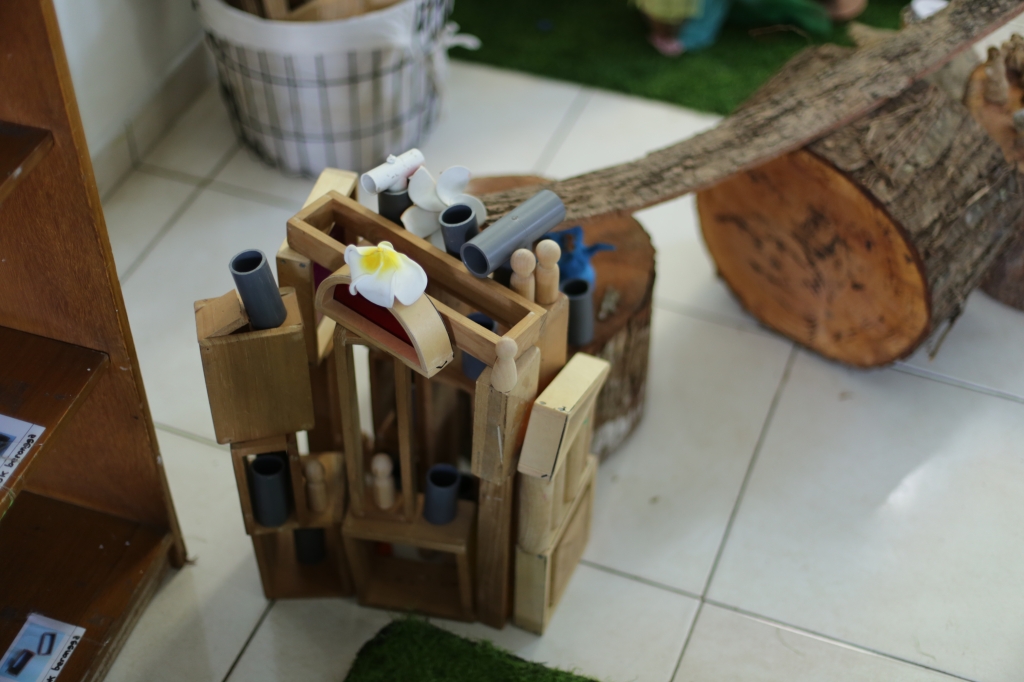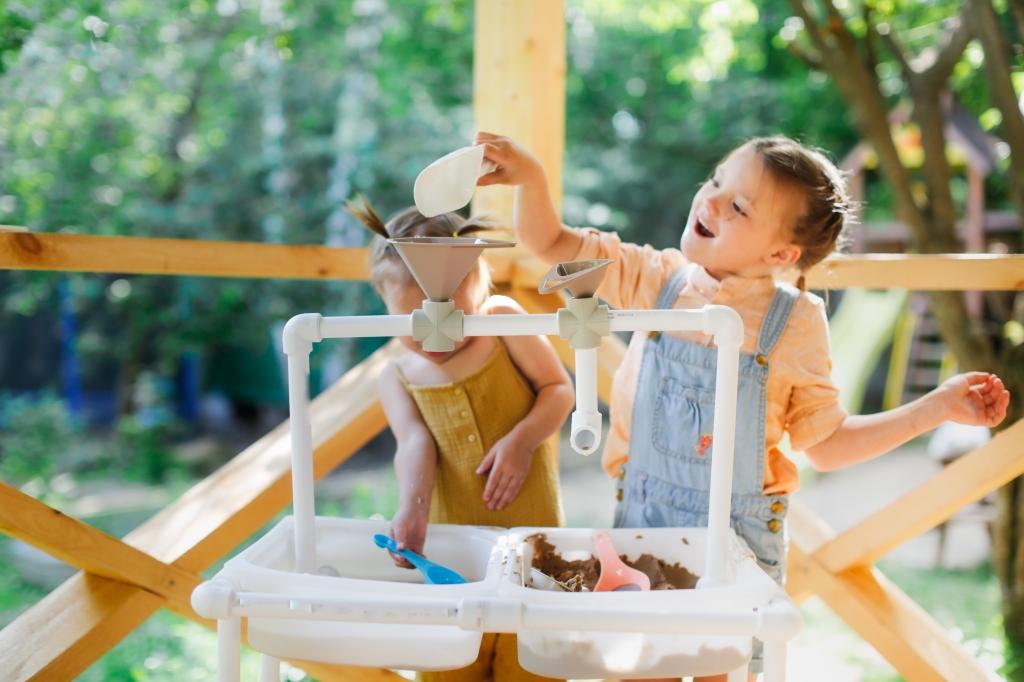
What Is Loose Parts Play?
Loose parts are natural and human-made objects that can be carried, moved, stacked, combined or taken apart by learners as part of their imaginative and creative play. Through construction and combining a range of materials, learners can use their brain and hands to think, imagine, solve problems and play creatively. Free play with loose parts provides a wide range of developmental opportunities – enhancing skills such as communication, teamwork, risk assessment and both gross and fine motor skills.
Loose Parts Play Theory was first developed in the 1970s by Simon Nicholson, an architect. He suggested that children should be provided with materials and objects that can be carried, transported, combined, stacked, dismantled and reused; and given time to explore, experiment and create using them without adult direction or instruction.
He theorised that this would provide children with opportunities to develop their imagination, creativity and problem-solving skills.
In modern educational settings, loose parts play is a commonly heard term and many environments include loose parts play without labelling it as such. Activities using building blocks, junk materials to create models and counting using small objects such as buttons are all examples of loose parts play.

How Does Loose Parts Play Support Child Development?
While some consider play to have little place in educational settings beyond nursery, academic studies overwhelmingly support the idea that play provides many benefits for learners in terms of their development.
One of the biggest benefits of loose parts play is the opportunity for learners to develop strong creative skills. Whilst many toys have a fixed purpose, the beauty of loose parts is that they provide endless imaginative play possibilities. A loose part can become whatever the learner says it is. A row of stacked stones can be a wall, a pine cone can be a person and a den made with piping and blankets can be a house. Play using loose parts is entirely open ended and with no rules to follow beyond basic safety, learners are free to engage with them however they choose. Developing imagination skills like this makes being creative in other contexts easier and in turn helps improve problem-solving skills required for curricular areas such as Science or Mathematics.
Loose parts play also provides opportunities for learners to build their interpersonal skills, including teamwork, communication and compromise. Using a shared set of resources involves countless opportunities for learners to interact with each other through discussions and negotiations. Even for those who choose to play independently initially, you will often find that the curiosity of other learners leads to interactions that then provide collaboration to further develop the play or materials being used. Fun is very contagious and as soon as one learner seems to be enjoying themselves, others will quickly want to join in.
Additionally, learners have opportunities to develop motor skills thanks to the play materials having a wide variety of shapes and sizes. It’s recommended that learners have the opportunity to choose from a broad range of both natural and human-made materials such as pine cones, pots, tyres, planks of wood and more. These provide the chance to stack, build, transport, carry and balance different shapes or weights which in turn means that learners can build their gross and fine motor skills. This is particularly important when you consider the availability of digital entertainment, as many learners will now prefer screen time to more active play.
Loose parts also provide opportunities for risky play. Developing an understanding of what is safe and what isn’t is an exceptionally important learning experience for young people. Before engaging with loose parts play, practitioners should ensure that resources are safe to be used by removing any hazards such as badly splintered wood, sharp edges or weaknesses. You should also discuss what is safe to do and what is not safe, providing the learners with age-appropriate examples and information on what they should do if they think something is unsafe or if somebody gets hurt. Beyond this though, learners should be free to experiment in a way that explores safe boundaries. Having the opportunity to build and test bridges or shelters provides learners the chance to understand which materials are strong enough for activities like this as well as whether or not they’ll be stable enough to function. Whilst our first reaction may be to stop a learner considering a risky move, you could use the opportunity to engage them in risk assessing through questioning and discussion.

Isn’t Loose Parts Play Just for Early Level Learners?
Whilst many people consider learning through play a vital part of most Early Level and some First Level learning environments, it’s often the case that very little time is dedicated to play in Second Level and beyond. However, there is little evidence to suggest that play would not benefit our older learners. Anecdotally, the impact of imaginative play on older learners can be just as significant.
Whilst working with Second Level learners, I was lucky enough to receive an hour per week block of loose parts play enabled by a local charity who provided all the equipment we needed. Whilst some learners took a little encouragement, by the end of our 8-week block all of my class adored their loose parts play time. Learners who found social interactions challenging had blossomed into confident young people who could connect with others through the various games they created. The beginnings of new friendships emerged and the widest grins I’ve ever seen could be found on nearly all of their faces.
Admittedly, this is only one instance showing benefits for older learners, but I often feel we forget that our Second Level learners are still children despite being the ‘grown-up ones’ in a primary school environment. Some of these learners might never experience play in this way, preferring instead to use games consoles or other digital technologies. We owe it to them to provide new environments to learn in, and loose parts play can be exactly that.

How Can I Incorporate Loose Parts Play Into Our Learning?
Like the idea of introducing loose parts play but not sure how to go about it? We’ve got you covered.
Pretty early on you will want to conduct a review of what loose-parts you already have available and what space you have for play. Auditing what equipment and space you have will allow you to see how practical it will be to start loose parts play sessions – you may need to look into sourcing further materials to really enable the play. You might have all the loose parts you need, but you also need a safe space for outdoor play. Concrete playgrounds and grassy spaces are both suitable for play, but ideally you would have access to both to allow the learners to explore fully.
You will also want to conduct a risk benefit assessment to analyse what could go wrong and how you can minimise that risk. However, by completing a risk benefit assessment you will also be able to identify what learners can gain from risky play. As we have already discussed, introducing learners to risky play can help them develop a broad range of skills that they can employ to keep themselves safe. The risk benefit assessment acknowledges the challenges, encourages practitioners to mitigate them and allows them to identify learning opportunities that can come from outdoor loose parts play.
Having taken account of both of the above, you will also want to consider engaging with parents, guardians and other relevant stakeholders to introduce them to the concept of loose parts play. In my experience there can be some hesitancy from parents around play as part of the curriculum, but by discussing the learning opportunities and benefits play has for all learners you can help to settle any concerns. You might consider hosting an information evening or even a loose parts session for parents and guardians to attend, allowing them to see the joy that free play brings to learners.
Once you have ticked these off the to-do list, you are ready to facilitate your first loose parts play session! Remember that you are there to observe and to enable the learners to play. It might feel tempting to get involved and show the learners how they can use the materials, but allowing them to engage as they choose opens them up to a world of discovery. You could consider using questioning to help learners engage, but try to take a step back when you can. If you’re not able to fit loose parts into your class schedule, you could consider an after-school session or a lunch session to engage learners.

Loose Parts Play Resources
Starting something new can be daunting, so we have a range of resources to enable loose-parts play regardless of your setting.
Introducing adults to the concept of loose-parts play is a great place to start, and to help with that we have created presentations for educators and for parents. We also have this Loose-Parts Play Adult Information Leaflet as well leaflets on learning through play and outdoor learning that you can use to help engage adults. We also have a presentation and leaflet all about creating an outdoor learning environment that may be particularly helpful if outdoor learning is new to your setting.
Thinking of risk benefit assessments, we have created this great adult information presentation to introduce the concept to staff along with this template you can use to complete your own assessment.
We have also created a checklist full of loose parts you can include in your provision. The checklist includes both indoor and outdoor materials, gives suggestions for safely storing materials and reminds practitioners to consider safety when checking the suitability of materials. The checklist is by no means an exhaustive list, but could be a great starting point for your own materials audit.
We also recognise that maintaining your loose parts is vital to ensure that play is safe and hygienic, and have created this Loose-Parts Play Resource Cleaning Checklist. The checklist includes suggestions of how to clean things as well as a rota to ensure everyone is taking care of the materials.
Finally, we have created a set of activity ideas to help kick-start your sessions if your learners need some inspiration. This set of activities is tailored to Early Level learners but can easily be adapted to suit older learners too. The suggestions include ways to integrate mathematics skills like estimation or measuring, as well as things such as den building or potion creation.

